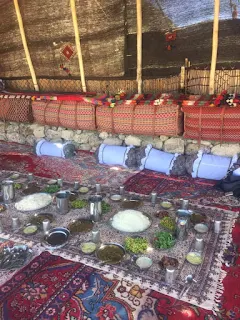Apart from its wonderful landscapes, the main interest of Iran lies in its people and its traditional and unique way of life. Today, nomads live in various areas of Iran and carry on ancient traditions.
 |
| Nomadic lifestyle |
Understanding this unique way of life is certainly the main goal of any traveller coming to Iran. Travelling in the land of nomads is a journey through time as well as through space, a discover that puts in perspective the obligations of our modern world. Nomadic accommodation is called yurt. A yurt can be quickly described as a circle tent covered with felt and with a white waterproof hard-wearing hessian.
Nomadism in Iran
The Iranian traditional life is based upon breeding of five animals: yaks, sheep, goats, camels, and horses. The products these animals give satisfy almost all the needs of the family: beef, mutton and goat's meat are an important part of the Mongolian diet; the sheep's wool is transformed in felt and used to make clothes, bedding, and insulating of yurts; horses, camels and yaks are used for transport; and even the hair and bones are used to make music instruments and toys
Nomadic traditional clothes
The Nomadic traditional costume consists of a deel, a hat, boots, and accessories. There are differences between the costumes of the various ethnic groups, but all the deels have the same shape: long sleeves, a wide flap that gets folded up on the chest.
Nomadic food
Because Nomadic culture is based on livestock farming, the Nomqdic traditional diet consists of food that comes from the five domestic animals: cow, goat and sheep.
Nomadic people usually eat a three full meals per day. During the day, they drink great quantity of tea with milk, sometimes mixed with rice, flour, meat, or with small cakes. The dinner includes meat, traditionally boiled, and often served with rice.


















